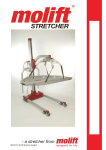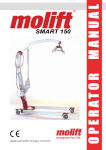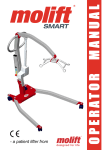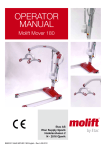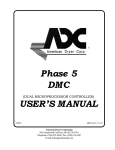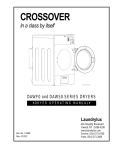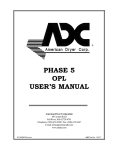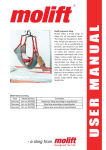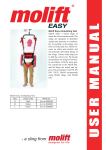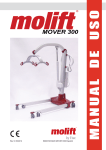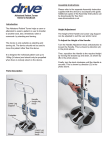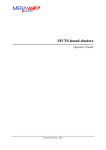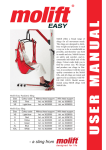Download User Manual - O Neill Healthcare
Transcript
Molift Patient Specific Sling Molift offers a broad range of slings for all movement needs. The slings are designed to distribute weight and pressure in such a way as to be as comfortable as possible, and therefore vary both in model and size. Molift focuses on safety and comfort, and recommends individual trial of the slings. Colour codes help you to find the correct size. We design and produce our slings in Norway, in accordance with the same quality constraints as the Molift lifts, and all slings are tested and approved in accordance with NSEN ISO 10535. Molift recommends using Molift slings with Molift lifts. Molift Patient Specific Sling Sling Size S M L XL Colour code Red Yellow Green Blue With head support Part. no 3050100 Part. no 3050200 Part. no 3050300 Part. no 3050400 - a sling from Molift Patient Specific Sling Molift Patient Specific Sling is a comfortable, padded sling designed for use with Molift’s 4 point suspension system. The sling is made of a light and environment-friendly material and is to be disposed after use. The inner fabric changes color when it comes in contact with water, meaning it should not be used. The sling is designed to be used by one patient only and can not be washed. Only use slings that are in good condition. Destroy and discard used slings according to national and local regulations. The sling is grey on the outside and white on the inside. If the white fabric on the inside has changed colour, the sling should be discarded and destroyed. Lifting and moving patients always involves a certain degree of risk. Read the lift’s user manual carefully! It is important to understand and be familiar with the equipment, and only trained personnel should use it. Ensure that the sling fits the lift you have chosen, and that it is correct for the situation it is to resolve. Show caution and care when you use the lift and its accessories because you, as a carer, are responsible for the safety of the patient. Molift Patient Specific Sling is designed to fit the Molift 4-point suspension and is intended as an accessory to Molift lifts. Using the sling Before use, fold the sling as shown in the illustrations. The grey side is turned away from the patient (user) to be lifted when positioning the sling. The sling is held in one hand, leaving the other free to support the patient. The white side must face the user’s back when positioning the sling. The lift suspension points must always be arranged across the user to be lifted, as shown to the left in the illustration below. Lift and movement to and from the seated position It is easier to lift from a seated position than from lying. If the user’s physique and abilities allow, he or she should be encouraged to participate actively when the sling is positioned. The user may, e.g. lift his or her thighs, pull out the leg straps, lean forwards, etc. • Lean the user forward while you hold one arm round him or her. Push the folded sling down behind the user’s back until it meets the seat. The sling can be pushed better into place using a flat hand in the positioning pocket behind the sling. Remember the correct working position to protect your back! Folding the sling • Pull forward the leg flaps by pulling on their edge bands and pull them under the user’s thighs. Pull forward and upwards. Then cross the loops on one of them through the other, as shown in the illustration. 2 Molift Paient Specific Sling - Eng Rev. D/ 09/2010 • Hook the loops onto the lift hooks. • If you are lifting from a wheelchair, apply the wheelchair brake so it does not move. Lift the user so he or she is clear of the chair, etc. and move him or her. You do not have to lift high. • If possible, turn the user to the recovery position. Fold the sling in the middle and place it behind the user’s back. Then turn the user over to the opposite side, and pull out the sling. Ensure that the user is positioned in the centre of the sling. Ensure that the lift loops are attached correctly to the lift before you begin to lift. The sling must NOT hang in the black tightening straps for the head support. • Lower the user carefully down into the chair, take the loops off the hooks and remove the lift. If moving to a wheelchair, the brakes must be on to prevent the wheelchair from moving. You can use the following techniques, or a combination of them, to get the user as far back in the seat as possible. - push the user’s knees gently - pull on the tapes at the back/on the sides of the sling - tilt the chair back Be careful when you lay the user on his or her side.Ensure that you hold the user back so he or she does not roll over and out of the opposite side of the bed. Remember the correct working position to protect your back! • Pull the leg flaps on the sling away from the underside of the user’s thighs. Stand by the side of the chair, lean the user forward while you are supporting with one hand. Pull the sling up from behind the user’s back. Lean the user back in the chair. • Pull out the leg flaps and position them under the user’s thighs, as shown in the illustration. If you pull the sling up hard, the user may fall forwards and be injured. Always hold one hand around the user as shown in the illustration. Lift and movement from/to the recumbent position. If the bed has a backrest, use this and follow the instructions for lifting and moving from the seated position. When lifting from a bed with height adjustment, adjust it to the correct working height. • Cross the leg loops by pulling one of the loops through the other. • Position the lift with the suspension points over the user. Ensure that you do not lower the suspension points down onto the user. Ensure that the suspension points are centred over the user before you lift. Remember that the wheels on the mobile lift must NOT be locked. 3 Size guide for sling sizes A C B Ensure that the sling is positioned correctly and that the lift loops are attached correctly to the lift before you begin to lift. The sling must NOT hang in the tightening straps for the head support. When lifting from a bed with height regulation, the bed should be lowered as much as possible. Be especially careful with the user’s head. • If users are to achieve the most comfortable seated position, it can be adjusted by pulling the handles behind and on the sides of the sling. Adjust the head support to a comfortable position using the tightening strap. • When lifting from a bed, the user is raised until the seat is off the mattress, then the legs are lifted and the user turned towards you so that the feet are outside the edge of the bed. • Carry out the movement, and lower the user carefully. Remove the loops on the sling from the suspension points. Roll the user towards you and fold the sling. Roll the user to the other side (preferably in the recovery position). Remove the sling and adjust the user in the bed. Size Colour code Recommended user weight (Kg) A (cm) B (cm) C (cm) XL Blue 160-240 76 116 104 L Green 90-160 66 101 98 M Yellow 45-95 56 86 92 S Red 25-50 51 76 80 The choice of sling size is determined by the user’s weight and body shape/size. SWL (Safe Working Load) is 300 kg for Molift Patient Specific Sling Materials Non-woven polypropylene fabric on ouside, polypropylene webbing and cotton/polyester inside. Labeling If this label is visible on the top back on the sling it should not be used. Be careful when you lay the user on his or her side. Ensure that you hold the user back so he or she does not roll over and out of the opposite side of the bed. Extension loops If necessary, extension loops can be used to achieve greater distance to the suspension points. The loops are used in pairs on the shoulder or leg loops. Art.no: 3013000 (2 piece set) Manufacturer: Molift Group AS Ole Deviksvei 44 N - 0668 Oslo 4 Supplier: - please see www.molift.com for complete list Molift Paient Specific Sling - Eng Rev. D/ 09/2010




